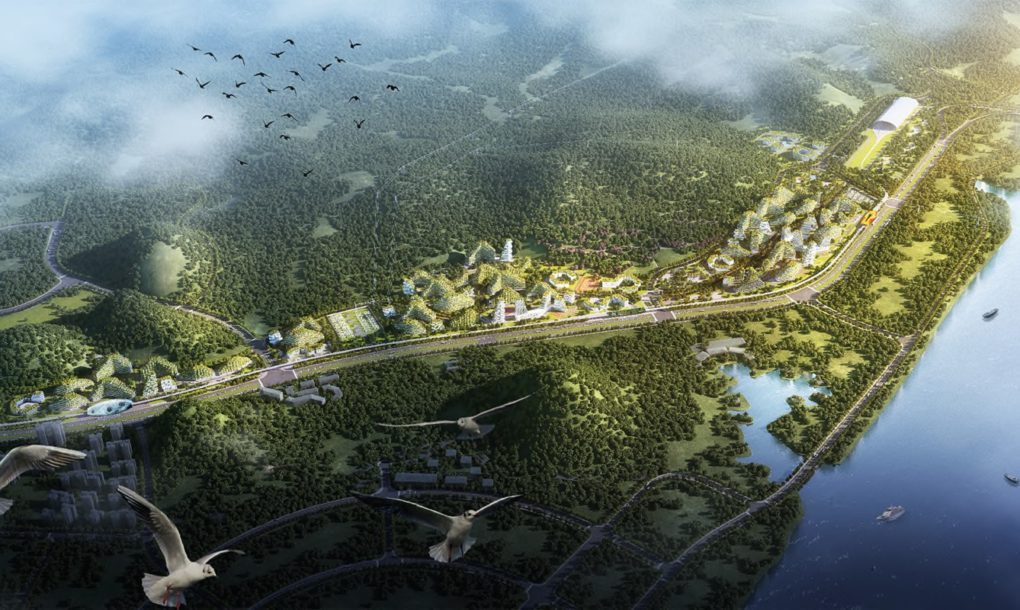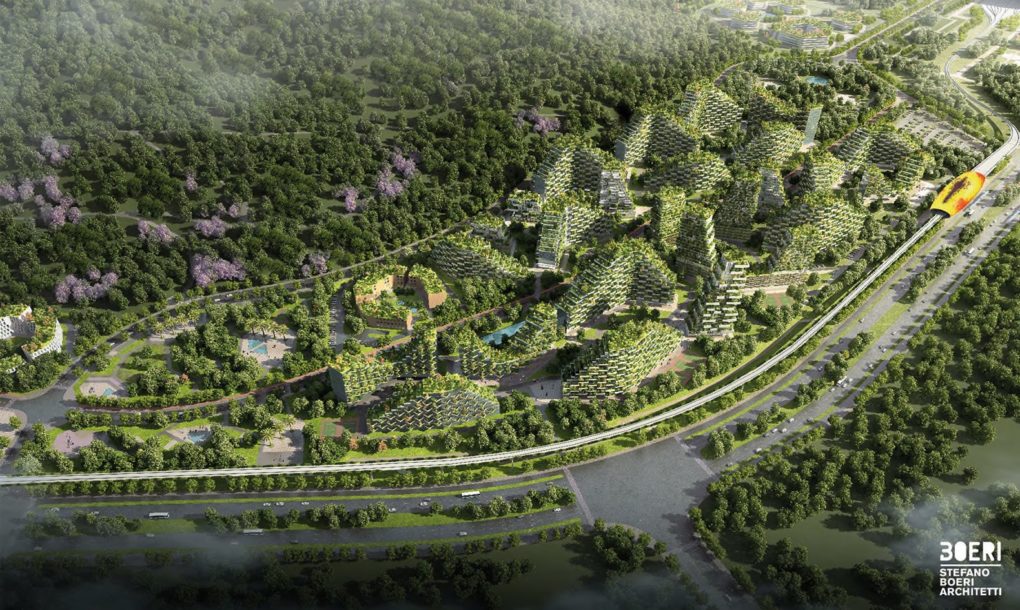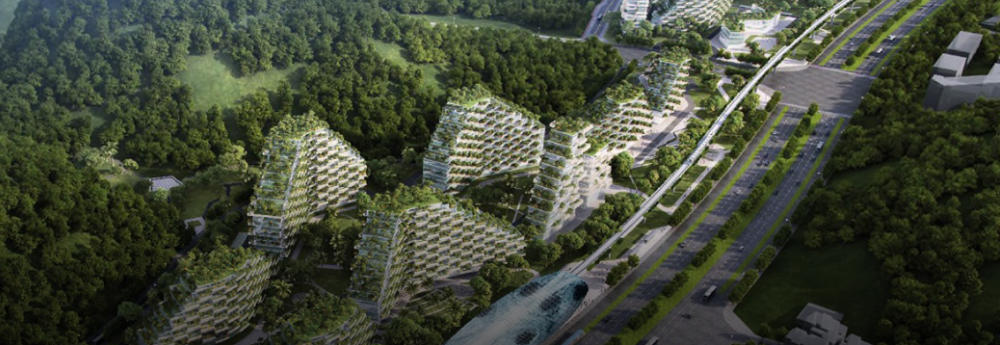China Has Officially Started Construction on the World’s First “Forest City”
The world’s first “Forest City,” designed to fight pollution and climate change, is under construction in China. Covered in greenery and trees, it will absorb nearly 10,000 tons of CO2 and 57 tons of pollutants yearly, and produce 900 tons of oxygen.
[edit] FUTURISTIC GREEN CITY
The world’s first “Forest City,” created to fight pollution, is now under construction in Liuzhou, Guangxi Province, China. Designed by Stefano Boeri Architetti, a team that develops green projects all around the world, the futuristic Forest City will be home to a community of about 30,000 people. It will be covered in greenery, including nearly 1 million plants of more than 100 species and 40,000 trees that together absorb almost 10,000 tons of carbon dioxide and 57 tons of pollutants, and produce approximately 900 tons of oxygen annually. As a result, Forest City will help to decrease the average air temperature, improve local air quality, create noise barriers, generate habitats, and improve local biodiversity in the region.
 Image Credit: Stefano Boeri Architetti
Image Credit: Stefano Boeri Architetti  Image Credit: Stefano Boeri Architetti
Image Credit: Stefano Boeri Architetti
Liuzhou Forest City will be self-sufficient, running on renewable energy sources such as geothermal and solar energy. The city will also be entirely wired, and will include commercial zones, residential areas, recreational spaces, a hospital, and two schools. Forest City will be connected to Liuzhou by a fast rail line for electric cars.
 Image Credit: Stefano Boeri Architetti
Image Credit: Stefano Boeri Architetti  Image Credit: Stefano Boeri Architetti
Image Credit: Stefano Boeri Architetti
Liuzhou Municipality Urban Planning commissioned the design for the 175-hectare Liuzhou Forest City which will be situated along the Liujiang River in the northern part of Liuzhou. The project has a high profile in China and, if it succeeds, it will set an example for green city design elsewhere in the country and around the world. The project is planned to be complete sometime in 2020.
 Image Credit: Stefano Boeri Architetti
Image Credit: Stefano Boeri Architetti  Image Credit: Stefano Boeri Architetti
Image Credit: Stefano Boeri Architetti
References: Inhabitat, Stefano Boeri Architetti
Written by Karla Lant, freelance writer, journalist, editor, Futurism
Please find the original article here .
--Future of Construction 10:15, 30 Aug 2017 (BST)
Featured articles and news
Independent Building Control review panel
Five members of the newly established, Grenfell Tower Inquiry recommended, panel appointed.
ECA progress on Welsh Recharging Electrical Skills Charter
Working hard to make progress on the ‘asks’ of the Recharging Electrical Skills Charter at the Senedd in Wales.
A brief history from 1890s to 2020s.
CIOB and CORBON combine forces
To elevate professional standards in Nigeria’s construction industry.
Amendment to the GB Energy Bill welcomed by ECA
Move prevents nationally-owned energy company from investing in solar panels produced by modern slavery.
Gregor Harvie argues that AI is state-sanctioned theft of IP.
Heat pumps, vehicle chargers and heating appliances must be sold with smart functionality.
Experimental AI housing target help for councils
Experimental AI could help councils meet housing targets by digitising records.
New-style degrees set for reformed ARB accreditation
Following the ARB Tomorrow's Architects competency outcomes for Architects.
BSRIA Occupant Wellbeing survey BOW
Occupant satisfaction and wellbeing tool inc. physical environment, indoor facilities, functionality and accessibility.
Preserving, waterproofing and decorating buildings.
Many resources for visitors aswell as new features for members.
Using technology to empower communities
The Community data platform; capturing the DNA of a place and fostering participation, for better design.
Heat pump and wind turbine sound calculations for PDRs
MCS publish updated sound calculation standards for permitted development installations.
Homes England creates largest housing-led site in the North
Successful, 34 hectare land acquisition with the residential allocation now completed.
Scottish apprenticeship training proposals
General support although better accountability and transparency is sought.
The history of building regulations
A story of belated action in response to crisis.
Moisture, fire safety and emerging trends in living walls
How wet is your wall?
Current policy explained and newly published consultation by the UK and Welsh Governments.
British architecture 1919–39. Book review.
Conservation of listed prefabs in Moseley.
Energy industry calls for urgent reform.































Comments
As of my last knowledge update in September 2021, China had announced plans for several ambitious eco-friendly projects, including the concept of a "Forest City." However, I don't have access to real-time information, so I cannot confirm events or developments that have occurred after that date.
If China has indeed started construction on the world's first "Forest City," it would be a significant step toward creating more sustainable urban environments. The concept of a Forest City involves designing and building a city that incorporates abundant greenery, trees, and vegetation into its infrastructure to improve air quality, reduce pollution, provide natural habitats, and enhance the overall quality of life for residents.
It's worth noting that such projects often involve complex planning, engineering, and environmental considerations. The success of a Forest City project depends on factors such as urban planning, design, sustainability initiatives, and the integration of green technologies.
If you're looking for up-to-date information about the progress of China's Forest City project, I recommend checking news sources, official government announcements, and reliable architectural and environmental websites.